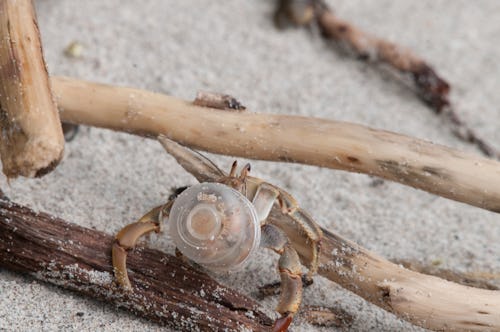
Look, we're all into weird stuff that we only search for when using Incognito mode. That's fine. We all just agree not to talk about it. But hermit crabs do not have this luxury. Instead of quietly searching for the things that excite them in the privacy of their own shell, they've been lured out into the open by plastic waste, which apparently is leaking a plastic additive that has a pheromone-like effect on the crustaceans that gets them going. Scientists at the University of Hull in England, the voyeurs that they are, have tracked this behavior and published a paper in the journal Marine Pollution Bulletin about it, kink-shaming the poor crabs.
Okay, so that's not exactly what is happening. But the truth is a little more depressing than horny crabs so why don't we live in that simple reality for just a moment longer?
Now, here's what's really happening. When plastic waste — which we dump into the ocean and other waterways by the ton — hits the water, it releases oleamide, a chemical compound that also occurs naturally and is known to be a sexual stimulant for some marine life. When the crabs detect the chemical, their respiration rate increases, which the researchers said indicates excitement and attraction.
But before you laugh at the poor hermits for treating waste like the crab equivalent of a Real Doll, here's a little bit more context: Oleamide is also very similar to oleic acid, a chemical that is released by arthropods during decomposition. Hermit crabs are scavengers, so the prospect of a rotting corpse is like hearing a dinner bell. The crustaceans will travel a long distance for what they think is a meal, only to be greeted with plastic.
"Respiration rate increases significantly in response to low concentrations of oleamide, and hermit crabs show a behavioral attraction comparable to their response to a feeding stimulant," PhD candidate Paula Schirrmacher, who worked on the study, said in a statement.
That's not great! Nor is it as entertaining as the thought of sexually repressed crabs getting their rocks off through weird stuff. In fact, it's pretty bad for the crabs. When these crabs spend more time around plastic, they ingest tiny particles from them, which can have devastating effects. Previous research published last year found that hermit crabs that take in microplastics have a harder time finding shells to live in. Not having a shell to huddle up in makes the creatures more prone to predators, which in turn hurts the environment because these little shelled scavengers aren't cleaning up carcasses.
You can forgive scientists for mixing up hungry and horny. We've all been there. But regardless of whether it's a hermit crab's stomach or another organ that leads it to plastic, our waste is messing with an essential part of the ocean's ecosystems. We really have to do something about that.







